|
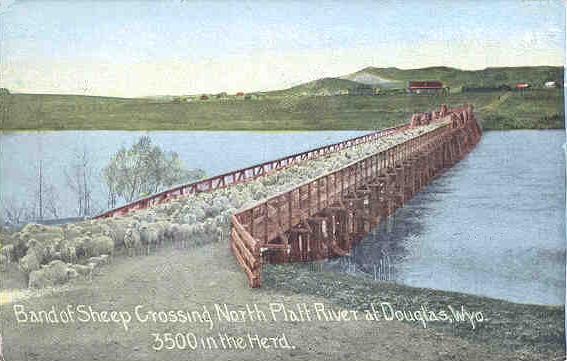
Sheep, Douglas, 1912
As noted on the previous page, settlement in
the Douglas area began in 1867 at Fort Fetterman while Douglas, itself, was established in
1886 with the arrival of the Railroad. Originally known as Tent Town, it was named
Douglas, as was Douglas, Georgia, in recognition of Stephen A. Douglas's
support for the transcontinental railroad. In the Senate, Douglas was responsible for
the extension of the Illinois Central to Chicago, thus, making Chicago the
rail hub on North America.
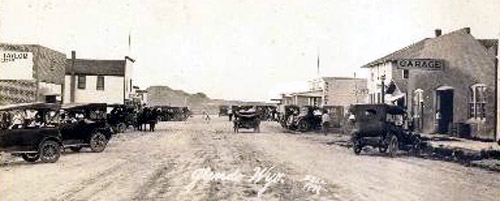
Glendo, approx. 1920. Glendo
is on the site
of Horseshoe Station, an early Pony Express and Overland Stage station. The
station was the location of the first telegraph station in the Territory and also
the home station for the Rocky Ridge Division of the Overland Stage and, thus,
the place of residence of Jack Slade (see discussion on
Ghost Towns page with regard to Point of Rocks Station which he robbed).
It was here, in fact, that Slade employed young Billy Cody as a rider.
Sir Richard Burton, the 19th Century British adventurer, in his 1860 log book of his cross-country
stage trip, commented on his overnight stay at Horseshoe Station:
"We were informed that ‘lady travelers’ were admitted into the house, but
the ruder sex must sleep where it could or not sleep at all if it preferred.
We found a barn hardly fit for a decently brought up pig; which had no door
and a damp floor. Into this disreputable hole we were all thrust for the
night even the federal judge amongst us whose position procured him only a
broken down pallet."
Sir Richard Burton August 14, 1860 9:30 PM
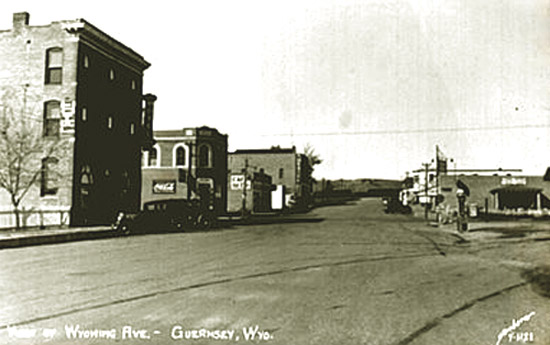
Guernsey, approx. 1939. Photo by William P. Sanborn
Present day Guernsey is on the site of
"Emigrant's Tub," a place along the Oregon Trail where, in the 1840's, pioneers
would stop to bath and wash their laundry.
One mile south of the town are the
Oregon Trail Ruts where wagon ruts made by the emigrants were literally worn into
the rock. Three miles from town are Register Cliffs where emigrants placed their
names. The earliest, believed to be that of a French trapper, is dated July 14, 1829.
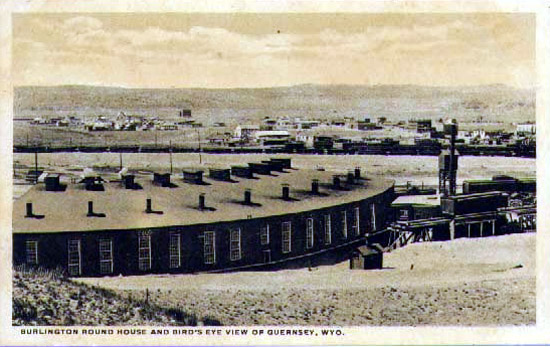
Burlington Roundhouse, 1907.
Guernsey, as a town, however dates
only to 1902. It was founded by the Lincoln Land Co., a subsidiary of the Burlington
Railroad and was named after Charles A. Guernsey. Guernsey was a
a state representative, mining developer and owner of a ranch at Register Cliffs and
the Three-Nines Ranch. The town was originally an ore shipping point on the railroad for ores from
mines at Hartville and Sunrise to the north of Guernsey. The Lincoln Land Co. also founded a number of towns
along the Burlington all across Nebraska as well as Kansas and eastern Colorado, chief among
them Scottsbluff. Stewart Culin visited the town at the time of its founding. In "A Summer Trip Among
the Western Indians," Bulletin of the Free Museaum of Sceince and Art, University of Pennsylvania, January 1901,
Culin described the little town which was undergoing a boom as a result of the opening of the
iron ore mines at Sunrise:
Some dozens of unpainted frame houses on the open praire, a railroad station, and a vast gang of
laborers engaged in building a railroad embankment were was all that was visible of the new
metropolis, in which corner lots were being offered for sale at metropolitan prices.
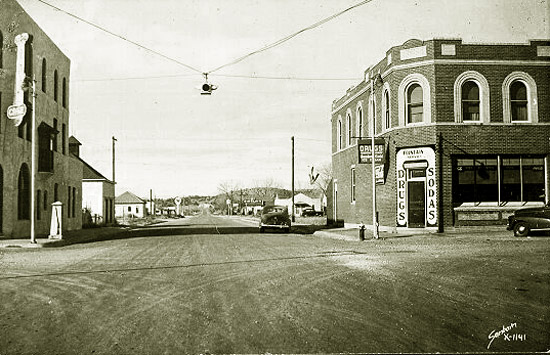
Guernsey, 1947. Photo by William P. Sanborn.
It was only appropriate that the town be named for Guernsey, for it was he who had brought the newly found
prosperity to the area. In 1900, Guernsey put together a number of mining claims at Sunrise and sold them to
the Colorado Fuel and Iron Company ("CF&I"). CF&I arose out of the construction of the Denver and
Reo Grande and the Railway's need for steel rail.
Next page: Sunrise and Hartville.
|